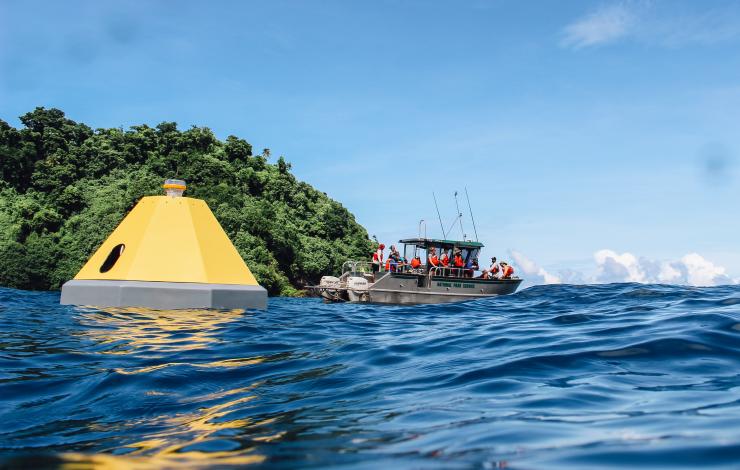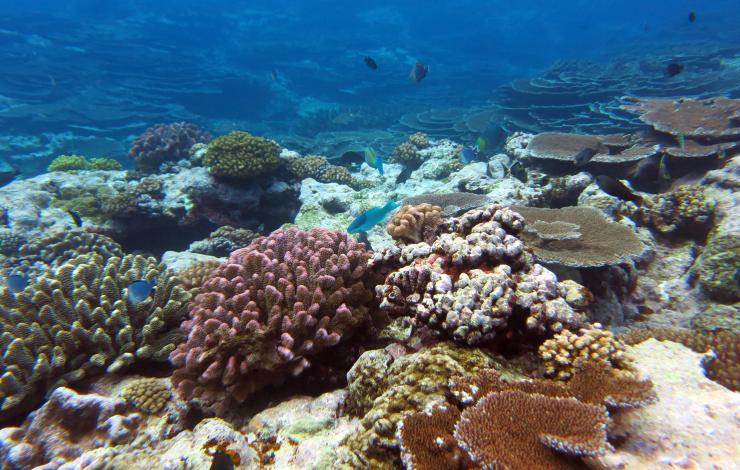NOAA and partners have launched a new buoy in Fagatele Bay within NOAA’s National Marine Sanctuary of American Samoa to measure the amount of carbon dioxide in the waters around a vibrant tropical coral reef ecosystem.
“This new monitoring effort in a remote area of the Pacific Ocean will not only advance our understanding of changing ocean chemistry in this valuable and vibrant coral ecosystem but will also help us communicate these changes to diverse stakeholders in the Pacific Islands and across the United States,” said Derek Manzello, coral ecologist with NOAA’s Atlantic Oceanographic and Meteorological Laboratory.
Fagatele Bay is home to more than 160 species of coral, as well as giant clams, fish, dolphins, and the critically endangered hawksbill sea turtle. Coral reefs and shellfish are particularly vulnerable to the impacts of increasing carbon dioxide in our ocean. As the ocean absorbs carbon dioxide from the atmosphere, the acidity of seawater increases. This is known as ocean acidification, which can threaten the ability of shellfish and corals to build their skeletons, hamper new coral growth and accelerate reef erosion. The loss of coral reefs impacts local economies, affecting the health of fisheries and tourism and exposing coastal communities to increased storm surge.
“The deployment of this buoy complements existing monitoring efforts in Fagatele Bay, and the data will be beneficial for all ocean management partners in the Territory,” said Atuatasi Lelei-Peau, Acting Superintendent of National Marine Sanctuary of American Samoa, “It was great to see the local resource management agencies come together to support this important project.”
Through an array of moored carbon dioxide buoys near our nation’s coral reefs, NOAA is working to improve our understanding of the impacts of ocean acidification on reefs and the species that depend on them. Each buoy collects data on carbon dioxide from surface seawater and the atmosphere as well as data on water temperature, salinity, pH, oxygen, and chlorophyll. A team of scientists also conduct long-term monitoring of the surrounding coral reef ecosystem.
“Each buoy is unique based on the location and partners involved,” said Adrienne Sutton, oceanographer at NOAA’s Pacific Marine Environmental Lab who oversees NOAA’s ocean acidification mooring network. “It takes a whole village to create and manage an ocean acidification observing site like this.”
The Fagatele Bay buoy is modeled on the ocean acidification monitoring station in Kāneʻohe Bay, Hawai‘i, which combines automatic environmental monitoring with applied science by government, cultural, academic, and citizen scientists. By deploying an ocean acidification monitoring buoy in the sanctuary, researchers are able to leverage existing monitoring and research programs to better understand the impacts of ocean acidification on coral reef ecosystems.
All data can be viewed online on PMEL and Pacific Islands Ocean Observing System (PacIOOS) websites and is available to other researchers and the public. Partners in the project include PacIOOS, the National Park of American Samoa, Department of Marine and Wildlife Resources of American Samoa, the Coral Reef Advisory Group of American Samoa, and NOAA’s Ocean Acidification Program, Pacific Marine Environmental Laboratory, Atlantic Oceanographic and Meteorological Laboratory, Coral Reef Conservation Program, Pacific Islands Fisheries Science Center, and National Marine Sanctuary of American Samoa.
Posted on research.noaa.gov on May 21, 2019.




